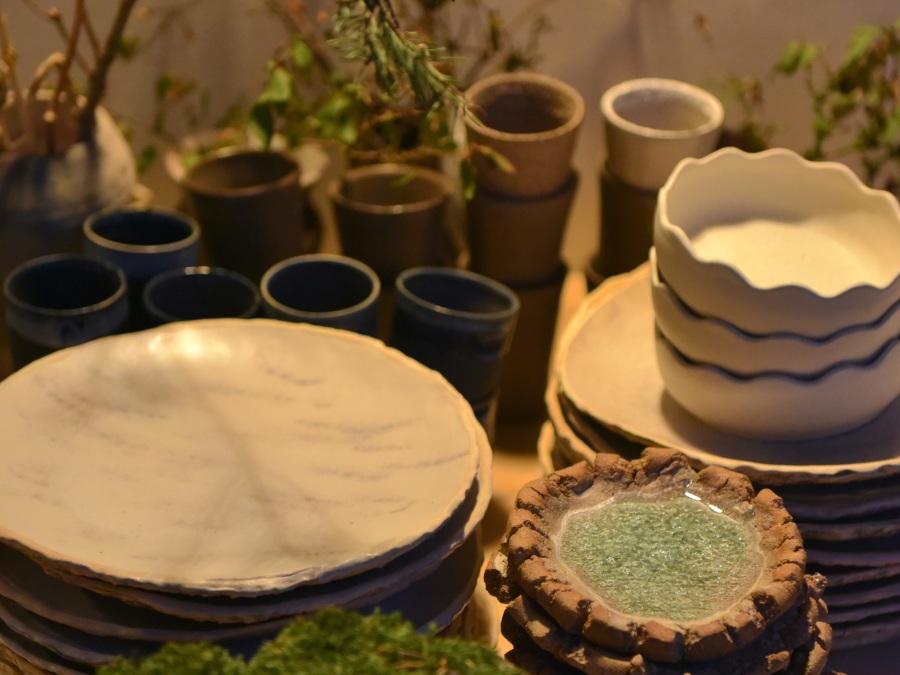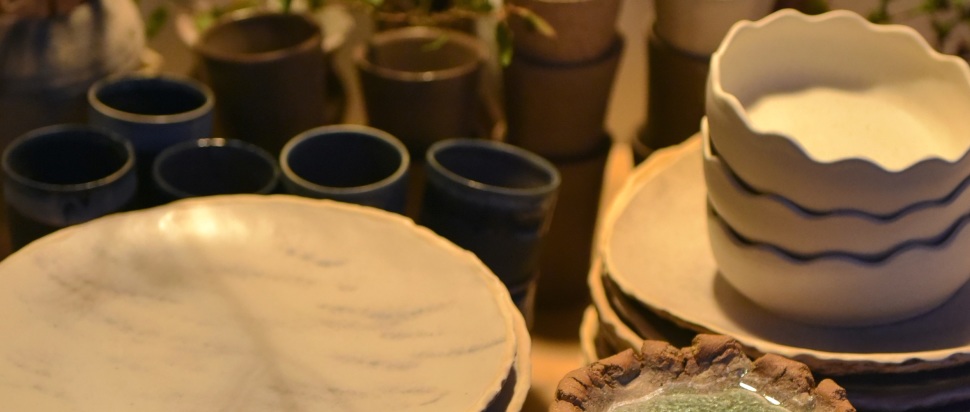Farm to Plate: MOSS restaurant and ViViVi Studio
Our design writer speaks to Akiko Matsuda and Henry Dobson about their collaboration for new restaurant Moss and their plans for their future in Scotland
Last year ceramicist Akiko Matsuda and chef Henry Dobson said goodbye to their home in the buzzing bohemian district of Shimokitazawa in Tokyo to settle in Edinburgh. This spring they opened a new restaurant called Moss on St Stephen’s Street, and ViViVi Studio for pottery on St Giles Street in Leith.
The restaurant serves high-end Scottish cuisine and has been developed as a rural diversification project to take advantage of the resources of the couple’s family farm in Angus. They aim to use as much as possible from their own farm with an emphasis on game, foraged ingredients, and farmed meats and vegetables. Examples from the current menu include a winter leaf gnudi with smoked anster and Jerusalem artichoke in an onion broth followed by a toasted chiffon with rose cream, apple and miso and fig leaf snow.
Aside from its highly distinctive menu, what makes this restaurant quite different is the desire to use resources from the farm that go past foodstuffs. Hardwoods for the furniture, clay for the tableware – even the paint on the walls was made using ash from the farm.
Eagle-eyed readers might recognise Akiko’s characteristic style when dining at Moss – she was one of 20 designers commissioned by Dundee Design Festival to create a unique pair of bookends and used clay from the farm and clay from Japan to create her piece Beyond. “Working with Akiko on the tableware was very special. Her work has made a huge impact on our dining experience and is one of the things our diners comment on the most,” says Henry, who trained at The Ballymaloe Cookery School in Cork and has worked at Noma, Kabi and MAZ.
Akiko describes her approach for Moss as something that evolved over time: “When I started working on the tableware project for Moss, we reflected on the inspirations we gathered in Japan, particularly during our time in Shigaraki, a renowned pottery centre. During our stay at the artist residency program there, I had the opportunity to explore and work with various types of clay. Even the tableware in the place we stayed felt like sculptural pieces, almost like natural rock formations.
“After returning to Scotland, my approach to ceramics evolved. I began to see texture and form differently, thinking more about how the shape of a piece could enhance the presentation of food. This shift in perspective has definitely influenced my creative process.”
Her pottery studio is called ViViVi Studio and she explains that the name comes from a Japanese onomatopoeia that represents the spark of an electric shock, “symbolising moments of inspiration, discovery, and imagination.”

Moss. Credit: Henry Dobson and Akiko Matsuda.
ViViVi Studio produces homeware designed to bring joy and a touch of excitement to everyday life, and through her workshops, Akiko aims to inspire creativity and provide hands-on experiences that spark imagination. Small, intimate classes are open to all ages and skill levels, making them perfect for beginners and for those looking to refine their pottery skills. There are handbuilding and wheel throwing classes, as well as Kintsugi – the traditional Japanese technique of repairing broken ceramics with gold.
How are the creative couple adapting to the shift in tempo, from a bustling megapolis with a population of 14 million to Edinburgh’s comparatively tiny half a million? “We absolutely love it here! The atmosphere is so relaxed and compact, and everyone seems genuinely happy to be here, excited about discovering new things and sharing stories. Having easy access to beautiful nature and historic places is truly a blessing.
“After living in London as a family, we felt that moving to Tokyo would be a great experience for both our daughter and ourselves. I also wanted them to explore and connect more deeply with my home and Japanese culture. Living and working in Tokyo was a wonderful time for all of us, filled with inspiration. In the end, we decided that Scotland would be the best place for us right now to start our own business and achieve a better balance between life and work,” says Akiko.
At first glance, Japanese and Scottish design and food culture seem to be very different, both in terms of how they are presented and discussed. Do Moss and ViViVi Studio look for the commonalities?
“I think both cultures share a deep commitment to craftsmanship and a pursuit of high quality,” says Akiko, adding: “In the UK, I feel there’s a stronger emphasis on individualism. Each brand and community has its own unique identity and story to tell, which I find truly fascinating.”
Henry explains that for him, Japanese and Scottish food culture are constantly evolving, often revisiting traditional styles and reimagining them with a modern touch. Starting both businesses must have been a mammoth task for a young family, but it seems that Akiko and Henry have the energy and commitment to make anything they do together a success.
“It feels like we finally have a platform to showcase our ideas and work every day! This year, I’d love to focus on updating and expanding our ceramic collection as much as possible. And I hope to make my new studio space a hub where people can connect through hands-on experiences and creativity.”
Moss, 112 St Stephen St, Edinburgh
For updates on the latest creations and workshops, follow @moss_edinburgh and @vivivi_studio on Instagram
@localheroesdesign
